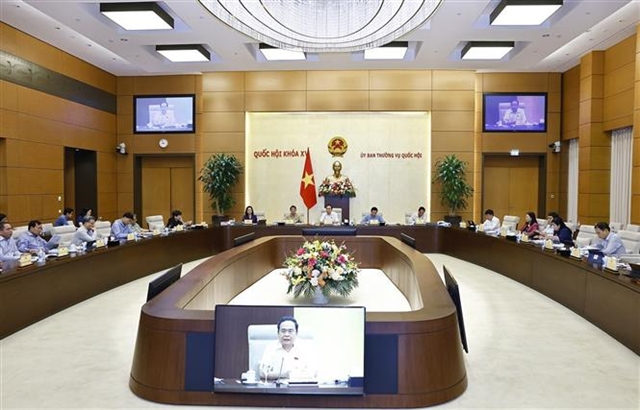 Politics & Law
Politics & Law

 |
| Deputy Prime Minister Lê Thành Long presents the National Target Programme for Drug Prevention and Control until 2030 at the 15th National Assembly (NA)’s ongoing eighth session on Friday. VNA/VNS Photo |
HÀ NỘI – At the 15th National Assembly (NA)’s ongoing eighth session on Friday, the Government proposed spending over VNĐ22.45 trillion (US$887.2 million) on drug prevention and control.
Presenting the proposal for the National Target Programme for Drug Prevention and Control until 2030, Deputy Prime Minister Lê Thành Long said that the global, regional and neighbouring countries’ drug situation is becoming increasingly complex and serious, directly impacting and increasing the risks and pressures on drug prevention efforts in Việt Nam.
Long noted that the domestic drug situation remains highly complex and unpredictable, with an upward trend in the number of cases, individuals involved and volumes of drugs seized.
“The number of drug addicts and illegal drug users remains very high, spanning all social classes, age groups, and localities. The number of communes, wards and towns nationwide facing drug problems has not decreased and accounts for a significant majority of 83.7 per cent,” he said.
Of the total proposed figure, the central budget would account for nearly VNĐ17.72 trillion ($700.2 million), the local budget for nearly VNĐ4.67 trillion ($184.5 million) and other legally mobilised funds are estimated at VNĐ50 billion ($1.9 million).
Reviewing the proposal, Nguyễn Thùy Anh, Chairwoman of the NA’s Committee on Social Affairs, stated that the total proposed funding for the programme is significantly lower than that of other national target programmes.
However, Thùy Anh emphasised that, given the substantial expenditure for development investment and social welfare during the 2026-30 period, the proposed allocation is appropriate.
To ensure timely and effective funding for the programme, the reviewing body recommended that the leading agency clarify the regulations on principles, criteria and allocation norms for the central budget, as well as the cost-sharing ratio of local budgets for implementing the programme.
It also called for specific plans for capital allocation, focused investment, avoiding fragmentation and waste, and a phased infrastructure investment plan, prioritising difficult and key areas.
Thùy Anh stressed that programme funds should not be used for activities already covered by regular state budget allocations for state management.
Additionally, it is necessary to clarify the plan for securing the projected VNĐ65 billion ($2.5 million) for 2025 in alignment with the 2025 state budget estimate, ensuring feasibility concerning the programme’s timelines and tasks.
Along with 20 targets, there are a number of general and specific objectives set forth, which are fundamentally aligned with the key and urgent tasks of drug prevention and control going forward.
The committee recommends that the leading agency in charge of developing the programme continue to review the general objectives to ensure they are comprehensive and holistic, combining prevention and control efforts, as well as reducing supply, demand and the harmful effects of drugs, thereby forming the basis for setting specific targets.
The reviewing body also suggested continuing to assess and align the objectives and targets with the core tasks and the funding capacity available for implementing the projects.
Deputy Trần Thị Kim Yến from HCM City's delegation agreed with the proposal and the reviewing body's report. She noted that each period witnesses significant fluctuations in drug trafficking, storage, and use.
“Previously, when authorities apprehended individuals involved in drug transportation or trafficking, they were often dealing with small packages measured in grammes. Now, there are cases involving tonnes,” she said.
According to Yến, the national target programme for drug prevention and control until 2030, which outlines three groups of objectives, is appropriate. Furthermore, the solutions and funding for each group of measures, Yến said, are also highly feasible and effective.
However, to achieve the overarching objectives outlined in the programme, Yến suggested additional measures to reduce social stigma against drug addicts and those who have completed rehabilitation.
“I still believe more solutions are needed, as social prejudice and employment opportunities for recovering addicts are crucial. If society views a single mistake as a life condemned, the reintegration of these individuals becomes extremely difficult. Additionally, if they do not have employment after rehabilitation, the risk of relapse is very high,” Yến said. – VNS




